10.6.2: Seawalls
- Page ID
- 16441
\( \newcommand{\vecs}[1]{\overset { \scriptstyle \rightharpoonup} {\mathbf{#1}} } \)
\( \newcommand{\vecd}[1]{\overset{-\!-\!\rightharpoonup}{\vphantom{a}\smash {#1}}} \)
\( \newcommand{\id}{\mathrm{id}}\) \( \newcommand{\Span}{\mathrm{span}}\)
( \newcommand{\kernel}{\mathrm{null}\,}\) \( \newcommand{\range}{\mathrm{range}\,}\)
\( \newcommand{\RealPart}{\mathrm{Re}}\) \( \newcommand{\ImaginaryPart}{\mathrm{Im}}\)
\( \newcommand{\Argument}{\mathrm{Arg}}\) \( \newcommand{\norm}[1]{\| #1 \|}\)
\( \newcommand{\inner}[2]{\langle #1, #2 \rangle}\)
\( \newcommand{\Span}{\mathrm{span}}\)
\( \newcommand{\id}{\mathrm{id}}\)
\( \newcommand{\Span}{\mathrm{span}}\)
\( \newcommand{\kernel}{\mathrm{null}\,}\)
\( \newcommand{\range}{\mathrm{range}\,}\)
\( \newcommand{\RealPart}{\mathrm{Re}}\)
\( \newcommand{\ImaginaryPart}{\mathrm{Im}}\)
\( \newcommand{\Argument}{\mathrm{Arg}}\)
\( \newcommand{\norm}[1]{\| #1 \|}\)
\( \newcommand{\inner}[2]{\langle #1, #2 \rangle}\)
\( \newcommand{\Span}{\mathrm{span}}\) \( \newcommand{\AA}{\unicode[.8,0]{x212B}}\)
\( \newcommand{\vectorA}[1]{\vec{#1}} % arrow\)
\( \newcommand{\vectorAt}[1]{\vec{\text{#1}}} % arrow\)
\( \newcommand{\vectorB}[1]{\overset { \scriptstyle \rightharpoonup} {\mathbf{#1}} } \)
\( \newcommand{\vectorC}[1]{\textbf{#1}} \)
\( \newcommand{\vectorD}[1]{\overrightarrow{#1}} \)
\( \newcommand{\vectorDt}[1]{\overrightarrow{\text{#1}}} \)
\( \newcommand{\vectE}[1]{\overset{-\!-\!\rightharpoonup}{\vphantom{a}\smash{\mathbf {#1}}}} \)
\( \newcommand{\vecs}[1]{\overset { \scriptstyle \rightharpoonup} {\mathbf{#1}} } \)
\( \newcommand{\vecd}[1]{\overset{-\!-\!\rightharpoonup}{\vphantom{a}\smash {#1}}} \)
\(\newcommand{\avec}{\mathbf a}\) \(\newcommand{\bvec}{\mathbf b}\) \(\newcommand{\cvec}{\mathbf c}\) \(\newcommand{\dvec}{\mathbf d}\) \(\newcommand{\dtil}{\widetilde{\mathbf d}}\) \(\newcommand{\evec}{\mathbf e}\) \(\newcommand{\fvec}{\mathbf f}\) \(\newcommand{\nvec}{\mathbf n}\) \(\newcommand{\pvec}{\mathbf p}\) \(\newcommand{\qvec}{\mathbf q}\) \(\newcommand{\svec}{\mathbf s}\) \(\newcommand{\tvec}{\mathbf t}\) \(\newcommand{\uvec}{\mathbf u}\) \(\newcommand{\vvec}{\mathbf v}\) \(\newcommand{\wvec}{\mathbf w}\) \(\newcommand{\xvec}{\mathbf x}\) \(\newcommand{\yvec}{\mathbf y}\) \(\newcommand{\zvec}{\mathbf z}\) \(\newcommand{\rvec}{\mathbf r}\) \(\newcommand{\mvec}{\mathbf m}\) \(\newcommand{\zerovec}{\mathbf 0}\) \(\newcommand{\onevec}{\mathbf 1}\) \(\newcommand{\real}{\mathbb R}\) \(\newcommand{\twovec}[2]{\left[\begin{array}{r}#1 \\ #2 \end{array}\right]}\) \(\newcommand{\ctwovec}[2]{\left[\begin{array}{c}#1 \\ #2 \end{array}\right]}\) \(\newcommand{\threevec}[3]{\left[\begin{array}{r}#1 \\ #2 \\ #3 \end{array}\right]}\) \(\newcommand{\cthreevec}[3]{\left[\begin{array}{c}#1 \\ #2 \\ #3 \end{array}\right]}\) \(\newcommand{\fourvec}[4]{\left[\begin{array}{r}#1 \\ #2 \\ #3 \\ #4 \end{array}\right]}\) \(\newcommand{\cfourvec}[4]{\left[\begin{array}{c}#1 \\ #2 \\ #3 \\ #4 \end{array}\right]}\) \(\newcommand{\fivevec}[5]{\left[\begin{array}{r}#1 \\ #2 \\ #3 \\ #4 \\ #5 \\ \end{array}\right]}\) \(\newcommand{\cfivevec}[5]{\left[\begin{array}{c}#1 \\ #2 \\ #3 \\ #4 \\ #5 \\ \end{array}\right]}\) \(\newcommand{\mattwo}[4]{\left[\begin{array}{rr}#1 \amp #2 \\ #3 \amp #4 \\ \end{array}\right]}\) \(\newcommand{\laspan}[1]{\text{Span}\{#1\}}\) \(\newcommand{\bcal}{\cal B}\) \(\newcommand{\ccal}{\cal C}\) \(\newcommand{\scal}{\cal S}\) \(\newcommand{\wcal}{\cal W}\) \(\newcommand{\ecal}{\cal E}\) \(\newcommand{\coords}[2]{\left\{#1\right\}_{#2}}\) \(\newcommand{\gray}[1]{\color{gray}{#1}}\) \(\newcommand{\lgray}[1]{\color{lightgray}{#1}}\) \(\newcommand{\rank}{\operatorname{rank}}\) \(\newcommand{\row}{\text{Row}}\) \(\newcommand{\col}{\text{Col}}\) \(\renewcommand{\row}{\text{Row}}\) \(\newcommand{\nul}{\text{Nul}}\) \(\newcommand{\var}{\text{Var}}\) \(\newcommand{\corr}{\text{corr}}\) \(\newcommand{\len}[1]{\left|#1\right|}\) \(\newcommand{\bbar}{\overline{\bvec}}\) \(\newcommand{\bhat}{\widehat{\bvec}}\) \(\newcommand{\bperp}{\bvec^\perp}\) \(\newcommand{\xhat}{\widehat{\xvec}}\) \(\newcommand{\vhat}{\widehat{\vvec}}\) \(\newcommand{\uhat}{\widehat{\uvec}}\) \(\newcommand{\what}{\widehat{\wvec}}\) \(\newcommand{\Sighat}{\widehat{\Sigma}}\) \(\newcommand{\lt}{<}\) \(\newcommand{\gt}{>}\) \(\newcommand{\amp}{&}\) \(\definecolor{fillinmathshade}{gray}{0.9}\)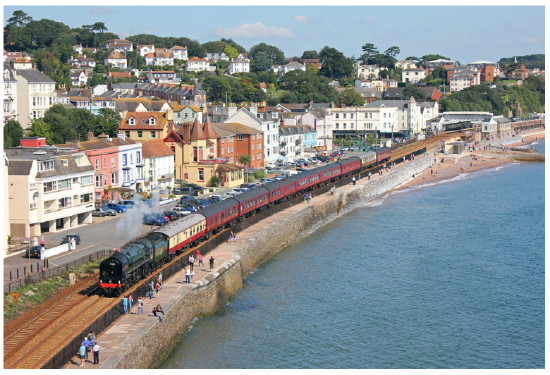
(a) normal conditions (photo taken in September 2015 by Wayland Smith)
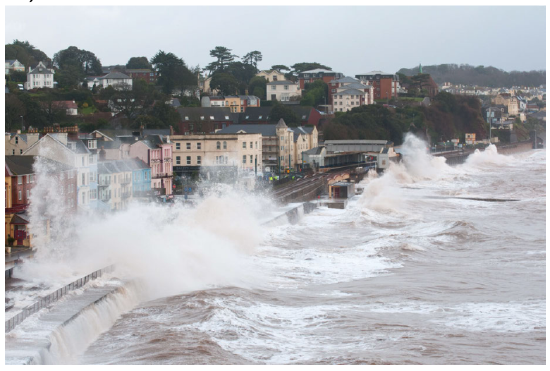
(b) storm conditions (photo taken in 2014 by Carol Blaker
Figure 10.22: A seawall in Dawlish, UK.
A seawall is a shore parallel and (nearly) vertical structure at the transition between the low-lying (sandy) beach and the (higher) mainland or dune (see Fig. 10.22). The seawall bridges the total height difference between beach and surface level of the mainland (often a boulevard, road or parking area). The seaward sloping surface of a seawall is generally smooth and impermeable.
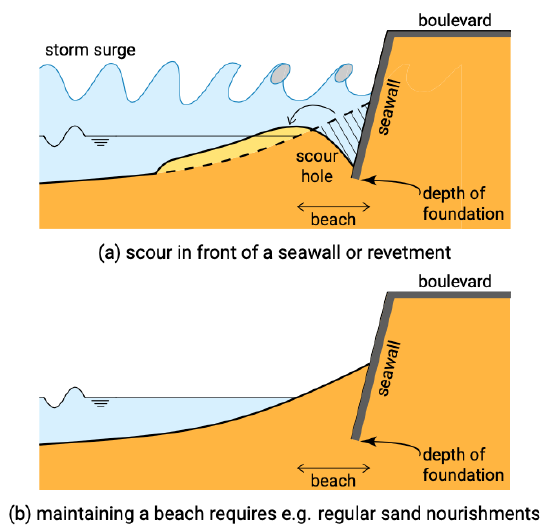
Seawalls are considered as a relatively easy to build coastal protection measure. The philosophy behind the concept is that storm erosion will be prevented by simply cutting off the local supply of material. While in a situation without a seawall even a moderate storm (surge) will attack and erode the mainland, in the situation with a seawall this is prevented. Unfortunately, a rigid massive seawall tends to reflect the incoming waves. The increased turbulence from this reflection may erode a deep trough along the toe of the sea wall (as in Fig. 10.23a). The presence of this trough endangers the foundation with the risk that the wall will fail by collapsing into the scour trough. This can be prevented by maintaining a beach in front of the seawall using some other means (e.g. regular artificial beach nourishments). If this is done, however, the logical question is: “why build a sea wall, then?” The only purpose of the seawall is then to provide a clear and fixed distinction between the beach and the mainland (a boulevard or road), see Fig. 10.23b. Staircases are needed to facilitate the access to the beach.
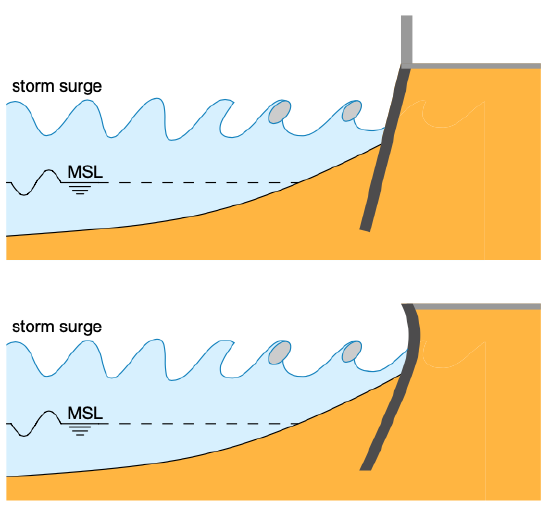
The design conditions for the seawall have to be properly chosen to provide the desired protection of infrastructure and buildings situated close to the edge of mainland or dunes. The larger the design wave conditions, the heavier the seawall must be and especially the foundation depth will increase accordingly. The crest height of a seawall determines (together with the boundary conditions at sea) to a great extent the rate of overtopping (water reaching the mainland by wave run-up and breaking waves and splash water transported by landward directed wind). With an additional wall and/or a slightly curved front, rates of overtopping might be reduced (see Fig. 10.24).
Let us consider a stretch of sandy coast. If unprotected, an extreme storm surge may cause a rate of mainland erosion of say 40 m. With a seawall which is able to with-stand these conditions the erosion of the mainland will be zero. Instead, in front of the seawall a deep scour hole will be formed. The scour does not present any problems as long as the seawall does not fail; the scour hole will slowly be re-filled during moderate wave and wind conditions. If, however, the seawall partly collapses and locally a gap in the seawall is formed a rather dangerous situation will occur. A large volume of sediment from the mainland may disappear through the gap and will flow in the alongshore directions along the sections of the seawall which are still in good condition, filling the scour trough. In this case, the final rate of erosion of the mainland behind the gap may be more than the 40 m as mentioned for the unprotected case.
Similarly, the unprotected coastline adjacent to a seawall may suffer from extra storm erosion since large amounts of sediment are lost to the scour trough.
Other than to prevent storm erosion, a seawall can be used to prevent flooding of low- lying hinterland if the existing row of dunes does not meet safety requirements (the dunes may for instance be too slender to withstand the design wave and water level conditions).
Neither seawalls nor revetments can protect a coast from structural erosion due to longshore transport gradients. Nevertheless, a large number of cases are known worldwide where seawalls have been applied – unsuccessfully, that is – to protect structurally eroding coastlines.
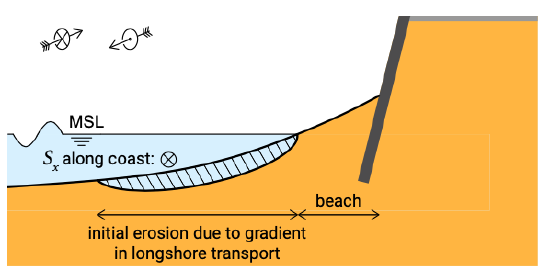
Structural erosion as a result of a gradient in longshore sediment transport means that volumes of sediment are irrevocably lost from the area under consideration. Due to the low frequency of occurrence of extreme conditions, the majority of the longshore sediment transport is due to moderate wave conditions and occurs in the area below MSL. The presence of the seawall does not prevent this (see Fig. 10.25). Due to cross-shore redistribution of sediments during high tides and/or modest storms, the alongshore loss of sediment causes a recession of the entire cross-shore profile in front of the sea- wall. This causes loss of the beach and deepening in front of the sea wall, which in turn results in an increased wave attack on the sea wall and possibly to damage and failure.
In the short run, the choice of seawalls as a protective measure seems to solve the erosion problems. Local citizens – whose property is endangered – have noticed in the past that every storm surge resulted in a loss of land. Just after the construction of a seawall the ‘protected’ parts of the coast do not show any signs of further erosion, whereas in the unprotected parts the erosion of the mainland continued. The seawall is therefore believed to function well. Unfortunately, after some time it will become clear that the structural erosion has not been countered at all. If coastal zone managers decide to apply seawalls as a countermeasure for structural erosion, this must be due to either lack of knowledge or pressure by the local citizens.


